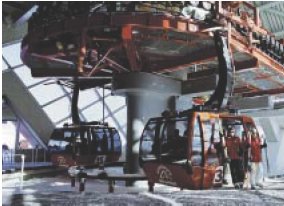Automation technology is currently developing away from a centralized control system with simple binary sensors and actuators into complex, intelligent systems. The proportion of control and process capacity within the sensors and actuators is constantly growing. This trend changes the communication requirements dramatically: Instead of the usual master/slave system that we see today, in future, more and more data will be exchanged
directly between the network subscribers. Today's individual, largely passive bus subscribers will increasingly assume the function of bus masters, with their own computing capacity.
Modern IT technology – as seen in office communication with personal computers and office network technology such as switches, routers etc. – currently offers a wide range of system components at favorable prices. There is huge potential for innovation. That's why users are increasingly keen to modify this technology to make it usable for industrial automation technology. Ethernet, which is practically standard in today's office communication, has a prominent role to play. When developing modern fieldbus systems, the aim in future must be to exploit the benefits of Ethernet to a greater extent. The installation of Ethernet systems must become simpler; compared with current fieldbus systems, Ethernet in its current form is still too complex.
The requirements of the individual elements of a production plant also continue to grow. This affects scan times, precision/frequency of measurements, data amounts and processor power, to name but a few. As far as the automation system is concerned, the performance of the process computer and communication systems must satisfy these growing requirements. As a modern, Ethernet-based fieldbus system, SafetyNET p meets these new requirements. At the same time, SafetyNET p is as simple to install and as reliable as today’s available fieldbus systems.
SafetyNET p system description
Safety-related communication via Ethernet is explained below, using the real-time Ethernet communication system SafetyNET p as an example. SafetyNET p is a multi-master bus system, i. e. all devices on the network have equal rights. The bus scan time of SafetyNET can be adapted to suit the application requirements.
Security
The protocol includes a safe data channel, which is certified for data transfer in accordance with SIL 3 of IEC 61508. Both safety-related and nonsafety-related data is transferred via the same bus cable. Non-safety-related subscribers have direct access to safety-related data and can use it for further non-safety-related processing tasks.
Flexible topology and scan time selection
SafetyNET p is extremely flexible, not just when it comes to selecting a suitable bus scan time, but also on the issue of the appropriate topology: The multi-master bus system supports linear, star, tree and ring topologies. The RTFL communication principle (Real Time Frame Line) is suitable for intra-cell communication, as it allows the fastest scan times. A minimum bus scan time of 62.5 μs can be achieved. Jobs and events can be recorded and executed with high precision across the entire network. Absolutely essential for real-time applications: a jitter of around 100 ns must be achievable in real-time control loops. As a result, it’s even
possible to use SafetyNET p in a frequency converter control loop between a rotary encoder and a speed regulator. Other highly dynamic applications are also possible, of course. RTFN mode (Real Time Frame Network) is used at higher levels, as it offers maximum coexistence capability with existing services.
Application layer
The interface with the application is made via widely-used CANopen technology. Existing CANopen devices can be converted to SafetyNET p devices simply by changing the transport layer.
Standard Ethernet technology
SafetyNET p uses Ethernet technology. The interface depends on the required performance level: If fastest possible communication is required, the RTFL communication principle is used, which is based on Ethernet OSI Layer 2 (MAC Frames). For communication via mixed Ethernet-based networks, from cell to cell or in general networks, UDP/IP communication is used. Conventional, standard Ethernet infrastructures can be used if the performance is satisfactory. This includes connectors, cables, routers, switches, gateways or communication channels.





